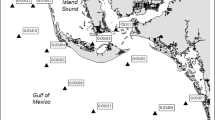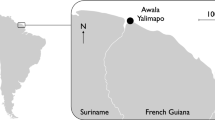Abstract
In 1984 and 1985 algal, macrofaunal and meiofaunal standing stocks were estimated on a exposed rocky shore along the west coast of False Bay, South Africa, using comparable, area-based sampling techniques. The shore supported a rich growth of algae, particularly in summer, when a maximum standing crop of 403 g m-2 was recorded in the low shore. In winter, the largest component of macrofaunal biomass comprised the filter-feeding barnacle Tetraclita serrata, which attained 75 g m-2 in the middle balanoid; but as a result of late recruitment and high mortality of this species, the summer shore was dominated by herbivorous gastropods, particularly Patella cochlear, which attained a maximum biomass of 66 g m-2 on the low shore. Meiofaunal numbers and biomass were closely correlated to the distribution of algal turfs and associated trapped sediments. Numerically, the most important components of the meiofauna were nematodes and copepods, while the biomass was more evenly shared among foraminifera, minute gastropods, copepods and insect larvae. Numbers and biomass peaked in the lower balanoid during winter (1.9×106 individuals, or 8.5 g m-2). Macrofauna:meiofauna numbers and biomass ratios are presented for each zone and the distribution patterns discussed in relation to the conditons in each. Numerically, meiofauna exceed macrofauna by an overall ratio of 1:391, with values ranging from 1:556 in the lower balanoid to 1:18 in the Littorina zone. Macrofaunal biomass exceeds that of meiofauna in all zones by an overall ratio of 10:1, but values range from 2.1:1 in the upper balanoid to 48:1 in the middle balanoid. By incorporating turnover ratios extrapolated from the literature, mean annual productivity ratios have been calculated. These indicate that macrofauna account for 75% of total secondary production and meiofauna for 25%. Failure to incorporate meiofauna in analyses of energy flow on rocky shore ecosystems would thus lead to considerable errors. The possible trophic role of meiofauna in such systems is discussed.
Similar content being viewed by others
Literature cited
Ankar, S. and R. Elmgren: The Ruppia subsystem. In: Ecosystem analysis of a shallow sound in the Northern Baltic; a joint study by the Asko group, pp. 64–71. Ed. by B. O. Jansson and F. Wulff. Contr. Asko Lab. (Univ. Stockholm) 18, 1–160 (1977)
Bally, R.: The ecology of three sandy beaches on the west coast of South Africa, 404 pp. Ph.D. thesis, University of Cape Town 1981
Beckley, L. E. and A. McLachlan: Studies on the littoral seaweed epifauna of St. Croix Island, 2. Composition and summer standing stocks. S. Afr. J. Zool. 15, 170–176 (1980)
Brinkhuis, B. H.: Seasonal variations in salt-marsh macroalgae photosynthesis 1. Ascophyllum nodosum ecad scorpioides. Mar. Biol. 44, 165–175 (1977)
Choat, J. H. and P. D. Kingett: The influence of fish predation on the abundance cycles of an algal turf invertebrate fauna. Oecologia 54, 88–95 (1982)
Coull, B. C. and J. B. J. Wells: Refuges from fish predation: experiments with phytal meiofauna from the New Zealand rocky intertidal. Ecology 64, 1599–1609 (1983)
Dahl, E.: On the smaller arthropoda of marine algae, especially in the polyhaline waters off the Swedish west coast. Unders. Over Øresund 35, 1–193 (1948)
Dale, N. G.: Bacteria on intertidal sediments; factors relating to their distribution. Limnol. Oceanogr. 19, 509–518 (1974)
Day, J. H.: A guide to the marine life on South African shores, 300 pp. Cape Town: A.A. Balkema (1969)
Edgar, G. J.: The ecology of south east Tasmanian phytal animal communities. 1. Spatial organisation on a local scale. J. exp. mar. Biol. Ecol. 70, 129–157 (1983 a)
Edgar, G. J.: The ecology of south east Tasmanian phytal animal communities. 2. Seasonal change in plant and animal populations. J. exp. mar. Biol. Ecol. 70, 159–179 (1983 b)
Edgar, G. J.: The ecology of south east Tasmanian phytal animal communities. 3. Patterns of species diversity. J. exp. mar. Biol. Ecol. 70, 181–203 (1983 c)
Elmgren, R.: Baltic benthos communities and the role of the meiofauna. Contr. Asko Lab. (Univ. Stockholm) 14, 1–31 (1976)
Eyre, J.: The South African intertidal zone and its relation to ocean currents 7. An area in False Bay. Ann. Natal Mus. 9, 283–305 (1939)
Gerlach, S. A.: Food chain relationships in subtidal silty sand marine sediments and the role of meiofauna in stimulating bacterial productivity. Oecologia 33, 55–69 (1978)
Gibbons, M. J. and C. L. Griffiths: Improved quantitative estimation of intertidal meiofaunal standing stock on an exposed rocky shore in False Bay. S. Afr. J. mar. Sci. 6 (In press)
Griffiths, R. J.: Population dynamics and growth of the bivalve Choromytilus meridionalis (Kr) at different tidal levels. Estuar. cstl Shelf Sci. 12, 101–118 (1981)
Gunnill, F. C.: Effects of plant size and distribution on the numbers of invertebrate species and individuals inhabiting the brown alga Pelvetia fastigiata. Mar. Biol. 69, 263–280 (1982)
Gunnill, F. C.: Seasonal variations in the invertebrate faunas of Pelvetia fastigiata (Fucaceae): effects of plant size and distribution. Mar. Biol. 73, 115–130 (1983)
Hicks, G. R. F.: Species composition and zoogeography of marine phytal harpacticoid copepods from Cook Strait, and their contribution to total phytal meiofauna. N. Z. J. mar. freshwat. Res. 11, 441–469 (1977 a)
Hicks, G. R. F.: Species associations and seasonal population densities of marine phytal harpacticoid copepods from Cook Strait. N. Z. J. mar. freshwat. Res. 11, 621–643 (1977 b)
Hicks, G. R. F.: Pattern and strategy in the reproductive cycles of benthic harpacticoid copepods. In: Cyclic phenomena in marine plants and animals, pp 139–147. Ed. by E. Naylor and R. G. Hartnoll. Oxford: Pergamon 1979
Hicks, G. R. F.: Structure of phytal harpacticoid assemblages and the influence of habitat complexity and turbidity. J. exp. mar. Biol. Ecol. 44, 157–192 (1980)
Hicks, G. R. F.: Meiofauna associated with rocky shore algae. In: Ecology of rocky coasts, pp 36–56 Ed. by. P. G. Moore and R. Seed. London: Hodder and Stoughton 1985
Hulings, N. C. and J. S. Gray: A manual for the study of meiofaunal. Smithsonian Contr. Zool. 78, 1–84 (1971)
Isaacs, W. E.: The geographical distribution of seaweed vegetation in relation to temperature and other factors with special reference to South Africa. Invest Rep. Oceanogr. Res. Inst., Durban 46, 1–72 (1938)
Jansson, A. M.: The food web of the Cladophora belt fauna. Helgoländer wiss. Meeresunters. 15, 574–588 (1967)
Jansson, A. M.: The Cladophora subsystem. In: Ecosystem analysis of a shallow sound in the Northern Baltic; a joint study by the Askö group, pp 47–53. Ed. by B. O. Jansson and F. Wulff. Contr. Askö Lab. (Univ. Stockholm) 18, 1–160 (1977)
Jansson, B. O.: The Fucus subsystem. In: Ecosystem analysis of a shallow sound in the Northern Baltic; a joint study by the Contr. Askö Lab. (Univ. Stockholm) 18, 1–160 (1977)
Kangas, P.: On the quantity of meiofauna among the epiphytes of Fucus vesiculosus in the Askö area, Northern Baltic. Contr. Askö Lab. (Univ. Stockholm) 24, 1–32 (1978)
King, R. J. and W. Schramm. Photosynthetic rates of benthic marine algae in relation to light intensity and seasonal variation. Mar. Biol. 37, 215–222 (1976)
Koop, K. and C. L. Griffiths: The relative significance of bacteria, meio- and macrofauna on an exposed sandy beach. Mar. Biol. 66, 295–300 (1982)
Mare, M. F.: A study of a marine benthic community with special reference to the micro-organisms. J. mar. biol. Ass. U.K. 25, 517–554 (1942)
McIntyre, A. D.: Ecology of marine meiobenthos. Biol. Rev. 44, 245–290 (1969)
McIntyre, A. D. and D. J. Murison: The meiofauna of a flatfish nursery ground. J. mar. biol. Ass. U.K. 53, 93–118 (1973)
McLachlan, A.: Studies on the psammolittoral meiofauna of Algoa Bay, South Africa. 2. The distribution, composition and biomass of the meiofauna and macrofauna communities. Zool. Afr. 12, 33–60 (1977 a)
McLachlan, A.: Composition, distribution, abundance and biomass of the macrofauna and meiofauna of four sandy beaches. Zool. Afr. 12, 279–306 (1977 b)
McLachlan, A.: Sandy beach ecology; a review. In: Sandy beaches as ecosystems, pp 321–380. Ed. by A. McLachlan and T. Erasmus. The Hague: Junk 1983
McQuaid, C. D.: Spatial and temporal variations in rocky intertidal communities, 331 pp. Ph.D. thesis, University of Cape Town 1980
McQuaid, C. D.: The establishment and maintenance of vertical size gradients in populations of Littorina africana knysnaensis (Phillipi) on an exposed rocky shore. J. exp. mar. Biol. Ecol. 54, 77–89 (1981)
McQuaid, C. D.: The influence of desiccation and predation on vertical size gradients in populations of the gastropod Oxystele variegata (Anton) on an exposed shore. Oecologia 53, 123–127 (1982)
McQuaid, C. D.: Seasonal variation in biomass and zonation of nine intertidal algae in relation to changes in radiation, sea temperature and tidal regime. Bot. mar. 28, 539–544 (1985)
McQuaid, C. D. and G. M. Branch: Trophic structure of rocky intertidal communities; response to wave action and implications for energy flow. Mar. Ecol. Prog. Ser. 22, 153–161 (1985)
Menge, B. A. and J. P. Sutherland: Species diversity gradients: synthesis of the roles of predation, competition and temporal heterogeneity. Am Nat. 110, 351–369 (1976)
Meyer-Reil, L. A., R. Dawson, G. Liebezeit and H. Tiedge: Fluctuations and interactions of bacterial activity in sandy beach sediments and overlying waters. Mar. Biol. 48, 161–171 (1978)
Moore, P. G.: The nematode fauna associated with holdfasts of kelp (Laminaria hyperborea) in N. E. Britain. J. mar. biol. Ass. U.K. 51, 589–604 (1971)
Mukai, H.: The phytal animals on the thalli of Sargassum serratifolium in the Sargassum region, with reference to their seasonal fluctuations. Mar. Biol. 8, 170–182 (1971)
Newell, R. C.: The biology of intertidal animals, 781 pp. Faversham: Marine Ecological Surveys 1979
Novak, R.: Spatial and seasonal distribution of the meiofauna in the seagras Posidonia oceanica. Netherlands J. Sea Res. 16, 380–388 (1982)
Reimer, A. A.: Description of a Tetraclita stalactifera panamensis community on a rocky intertidal Pacific shore of Panama. Mar. Biol. 35, 225–238 (1976a)
Reimer, A. A.: Succession of invertebrates in vacant tests of Etraclita stalactifera panamensis. Mar. Biol. 35, 239–251 (1976 b)
Sarma, A. L. N. and P. N. Ganapati: Faunal associations of algae in the intertidal region of Visakhapatmam (India). Proc. Indian nat. Sci. Acad. 38, 380–396 (1972)
Stephenson, T. A.: The constitution of the intertidal fauna and flora of South Africa. J. Linn. Soc. Lond. (Zool.) 50, 487–536 (1939)
Stephenson, T. A.: The constitution of the intertidal fauna and flora of South Africa. Pt. 2. Ann. Natal Mus. 10, 261–358 (1944)
Stephenson, T. A.: The constitution of the intertidal fauna and flora of South Africa. Pt. 3. Ann. Natal Mus. 11, 207–325 (1948)
Swedmark, B.: The interstitial fauna of marine sand. Biol. Rev. 39, 1–42 (1964)
Wieser, W.: Investigations on the microfauna inhabiting seaweeds on rocky coasts. 4. Studies on the vertical distribution of the fauna inhabiting seaweeds below the Plymouth Laboratory. J. mar. biol. Ass. U.K. 31, 145–174 (1952)
Author information
Authors and Affiliations
Additional information
Communicated by O. Kinne, Oldendorf/Luhe
Rights and permissions
About this article
Cite this article
Gibbons, M.J., Griffiths, C.L. A comparison of macrofaunal and meiofaunal distribution and standing stock across a rocky shore, with an estimate of their productivities. Mar. Biol. 93, 181–188 (1986). https://doi.org/10.1007/BF00508255
Accepted:
Issue Date:
DOI: https://doi.org/10.1007/BF00508255




